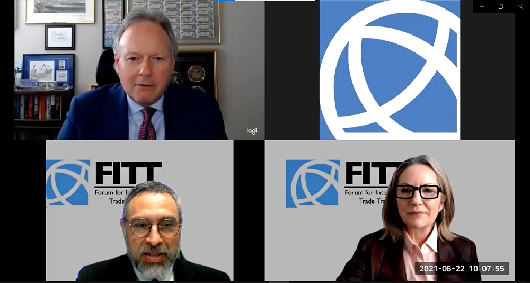
The word ‘globalization’ evokes strong sentiments in our current times. For some, it represents a practice that has been occurring for centuries: trade between countries, while for others it means the loss of jobs, offshoring, protectionism, and geopolitical tensions. With the onslaught of the pandemic, these tensions have become more prominent, but they are also opening doors to meaningful and important conversations about the evolution of global business and trade.
Recently, FITT hosted an event with Stephen Poloz, CITP, Special Advisor at Osler, Hoskin & Harcourt LLP, and the former Governor of the Bank of Canada to discuss the future of globalization. He noted that it is not a black or white scenario and much of the backlash against it can be attributed to a variety of factors often overlooked by mainstream politics and media. Poloz’s upcoming book, “The Next Age of Uncertainty: How the World Can Adapt to a Riskier Future,” touches on a few of these topics, while for our event, he specifically dove into the foundations, risks, and solutions to post-pandemic globalization.
The event was hosted by Caroline Tompkins, CITP, President and CEO, FITT and moderated by Alberto Quiroz, CITP, President, Intellimeter Canada Inc. and Chair, FITT Board of Directors, and garnered some excellent questions and insights into the topic.
Read some of the most fascinating excerpts and quotes by Stephen Poloz from the event transcript below:
Globalization, COVID-19, and the effects on the global economy
“There’s no doubt that the pandemic has shaken our foundations. It will have permanent effects on the global economy and on how we do business. But much of what I have to say today was in motion long before COVID-19 came along. The pandemic might have accelerated some of those things, but they were already there and they were destined to affect our future.”
Economic Resiliency
“Just to illustrate, here in Canada, the economy did shrink by about 20 percent last April to May (2020), which is a pretty big number—but it’s not maybe as big as I might have thought. You know, if you shut down the whole economy, would you expect that around 80 percent would just keep running? That surprised me a little. The declines in the economy here in Canada lasted only two months as the economy began to grow again in June, last year, and by the fall we were operating at 97 percent of pre-pandemic levels of economic activity—and right now we’re 98 to 99 percent of pre-pandemic levels. You wouldn’t know that probably by watching the news.”
Erroneous comparisons to The Great Depression
“We’re hearing mostly about the sectors that have been hit directly by the COVID-19 shutdown…but the key to this is that each time we have closed the economy, the unaffected sectors have continued to do well. There’s been no spread of the negative sentiment from the directly affected sectors to the rest of the economy, and this is exactly why those comparisons last year to The Great Depression were so inappropriate and actually totally misleading. A recession happens when your next-door neighbour loses their job and they cut their spending and, when you hear about it, you cut your spending too because you’re worried that you might be the next one to lose your job. Well, not in this case. We had very fast policy responses—monetary policy and especially fiscal policy—and not to mention the fact that our banks allowed people to take holidays from paying their mortgages. These were really big buffering actions and they enabled us to stop the clock in certain sectors and allow the rest of the economy to continue to run. This is exactly why economists have been pretty uniformly surprised at each stage of the global recovery.”
Sources of discontentment related to globalization
“The source of this discontent, I think, the most important one, is rising income inequality. Data from the UN shows very clearly that income inequality has risen for over 70 percent of the world’s population over the past 30 years. The reasons for this vary from country to country, but the common denominators are technological progress, rising corporate concentration, eroding labor bargaining power, and, of course, globalization—and all these things actually tend to go together. There’s a lot of research on this question and as an economist…it’s quite clear that the root cause is actually technological progress.
“Technological change has been a constant throughout human history, as we know, from the very beginning, but it’s been punctuated by three major waves of change and we call those industrial revolutions. These were the steam engine during the 1800s, the spread of electrification in the early 1900s, and the deployment of the computer chip beginning in the late 1970s. Each of these technological leaps has delivered untold benefits to society in terms of quality of life, productivity, and of course income, but, at the same time, companies have had to adapt to new technology or be forced out of business—that’s highly disruptive. These disruptions are particularly hard on people, on employees… many of them lost their jobs permanently, even though many new jobs were being created in the background.”
“A key feature of all three industrial revolutions is that the economic benefits of the new technology do not get spread around. You might imagine it being spread around like yeast, you know getting into every crack so everybody gets some. But instead, the benefits to technological progress tend to pop up more like mushrooms. So, not yeast— mushrooms and then the mushrooms get collected by a few large firms and firms get bigger as a result. So, historically technological change has also always been associated with rising income inequality and worker discontent and, of course, opportunistic politicians are tapping into this discontent.”
The third and fourth industrial revolutions
“Notice that the peak period of adjustment to the third industrial revolution also corresponds to the peak in the globalization wave that followed China’s entry into the WTO. So, during the past generation, we’ve got these two major forces that are helping to contribute to rising income inequality. Now, politicians, it seems, prefer to point to globalization as the main reason for rising income inequality. Maybe it’s easier to identify—displaced workers can certainly identify—that there’s foreign competition perhaps that has caused their displacement. And, of course, it’s deceptively easy to fix. You just impose tariffs to protect people from the disruptions.”
“But let’s just take a moment to walk through the full impact of a technological leap. Firms deploy the new technology and, of course, as we know, people lose their jobs because of that new technology—and the companies make a bigger profit. New jobs in the new technology, they make good money too. Income inequality rises—absolutely it does—because many people are disrupted and don’t have work at all. But now two things happen: prices fall—prices of all the things that use the new technology fall—because the companies are more efficient. So, purchasing power of people with incomes rises significantly and the people who are making big money from the innovation spend their purchasing power too. So, those two channels of spending create jobs across the entire economy: that’s people who don’t just make, let’s say, cars, but people who build houses, people who are plumbers or electricians or furnace repair people. All these kinds of jobs are created because the level of income throughout the economy goes up that creates new jobs in the economy that no one, and I mean no one, points to as a benefit of technological progress.”
“You could ask exactly the same question about the full and complete effects of globalization and the story is exactly the same as it is for technological progress. Firms make money, prices fall, purchasing power rises, jobs are created that, again, no one points to as a benefit from globalization. So this basic confusion is what I think is driving political polarization around the world and causing politicians more often to intervene in trade.”
The third and fourth industrial revolutions and the “K”-shaped economy
“We’re now just entering the fourth industrial revolution and that’s the digitization of all parts of the economy. AI, bioengineering, and amazing leaps in technology…. COVID-19 is for sure accelerating the adoption of new technology in all kinds of dimensions. This points to what I call, ‘K’-shaped economy…in other words, people who are being disrupted go to the bottom part of the “K,” the rest of the economy grows well into the top part of the ‘K.’ We look at the economy as a whole—it may look more or less normal, but beneath the surface, there’s a lot of pain in some areas.
“This is going to become highly political and therefore increase political polarization and the inability, given that polarization, for governments to really forge a consensus around the policies that would actually address inequality—that would be major tax reforms, as I’m sure you’re aware. It’s going to lead to more intervention in the global trading system, as a sort of second-best, and, I think, generally counterproductive way to manage political risks from those discounted, discontented individuals. And, it’s going to lead to haphazard trade policies that will fuel geopolitical tensions because every trade policy that you put in place in one country affects another country. That makes the global trading system inherently unpredictable and riskier overall—with the root cause being is rising income inequality that’s coming from that technological wave now.”
How trade-dependent companies can adapt to a riskier trade environment
“Higher risk in general means devoting more resources to active risk management. It means more frequent use of scenario planning and updating those scenarios frequently—not just once a year to prove to the board that you’re on top of your risk, but rather to develop them every time the starting point is changing… to do a whole new set of scenarios, have it all automated so you can keep them up to date. It means the company needs dedicated resources to risk management. A firm that does a good job with risk management will create more shareholder value than one that does not.”
To me, risk management is like a new form of intangible investment— like the way companies invest in their brands or the way they invest in their employees. It’s a cost item. It doesn’t look like equipment or real investment but, believe me, it is because it pays off year after year.

Why de-globalization and automation aren’t favourable risk management strategies
“What will companies do in practical terms? Well, it’s a few options and I always want to run through them even though maybe one or two of them are just strawmen:”
Reshoring and de-globalizing
“The first option is to avoid it all. You can reshore everything, you can de-globalize the company. Now, this is seen by many as the ultimate form of de-risking, and the governments who are advocating for disruptions of international trade love it because it seems that it would create local jobs, for example. Creating a lot more local jobs—building, for example, household appliances—well the tariffs that the U.S. put in place to try and encourage reshoring of household appliance manufacturing added pretty close to a thousand dollars per year onto the costs of every American household. Now, this is money that was no longer available [for citizens] to spend on other things, including things like, let’s say, upgrading their kitchen. Now there are lots of lost jobs in the construction sector because people no longer have the resources they would like to have to do put a deck on their house, so those jobs that are lost in the construction sector will not be identified as a side effect of a policy designed to reassure the manufacturing of appliances into the United States.”
Automation
“The second option that companies might consider is full automation. So, given higher domestic wages, partial automation is always part of reshoring. Okay, so you reoptimize. You bring stuff onshore, wage costs are higher, so you figure out what’s the appropriate capital-labor ratio and, of course, you buy a few robots to compliment the people who are on the line. The point is that you may not create as many jobs as the politicians were hoping you would—but the full risk management strategy may be able to make a plant full of robots and a handful of technology exports. So, you could just have all robots and just a few folks running the system with a mouse. This is the ultimate backfire for the politician, so there is always a risk that something else will change after that optimization happens. So, the full automation option…I don’t think it’s the way to go, but I do think that to the extent that reshoring is forced by government policies, one of the downsides for the strategy is that there will be lots of automation that happens in the process and so fewer jobs will be created domestically than originally imagined.”
Why we should keep supply chains as they are but manage the risk differently
“The third option which is starting to sound more appropriate is to keep the supply chains as they are but manage the risk differently. So, you preserve the value that’s being created in the global value chain but perhaps give some of it back in order to manage the risk.”
Globalization has always been portrayed as just black or white. You know, either you’re globalized, or you’re not globalized—either you’re doing trade you’re not doing trade. Well, a supply chain was always going to be fluid and a living thing and re-optimized often. An optimal global supply chain requires full product fragmentation and each fragment of the process matched with exactly the right skill set and the wage cost in some other country. So, when relative wages change, the optimal suppliers of some fragments will change and therefore the supply chain needs to be continuously revised as we go through time.
Ways to manage trade and geopolitical risk
“So, what we need to think of is trade risk or geopolitical risk. Call it what you want, it’s just one more cost or cheap thing that can change that forces a company to re-optimize that global supply chain. So, re-optimizing the supply chain more often or more continuously—that’s, of course, going to cost money but it’s a form of insurance against the risk that we’re talking about. Re-optimizing the supply chain can be thought of as right-shoring or best-shoring if you like. So, practical examples would be create redundancies to reduce risk so if you have to you have one fragment of the process reliant on one supplier, well, find a second supplier and run the system with two suppliers in two different countries for exactly that same fragment. That’s just a risk mitigation strategy. It might cost a little bit but that’s a small cut price to pay in exchange for having a place you can go when something goes wrong because of geopolitical tensions at the top.
“Secondly, build flexibility into contracts with suppliers from the beginning, so that you’re not committed for a long time so the continuous scenario analysis or business continuity planning allows the movement from one supplier to another.”
“The third sort of thing that we hear about is nearshoring that’s exploiting nearby trade agreements that offer legal protections for the firm. So, for Canadians, for example, you know using Mexico as a supplier instead of a producer out in Asia maybe gives you more protection just because CUSMA is going beyond all this.”
Want to get more insights from the event? Watch it here:






disqus comments